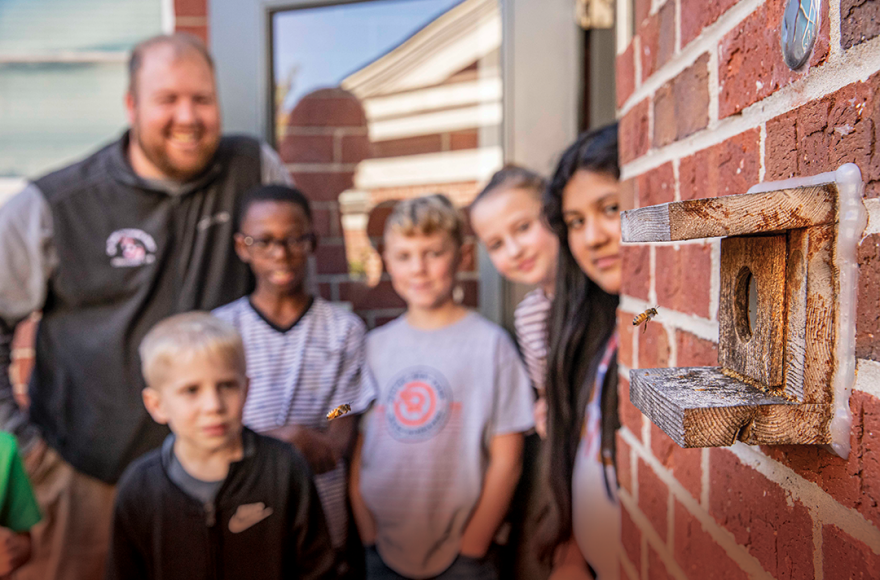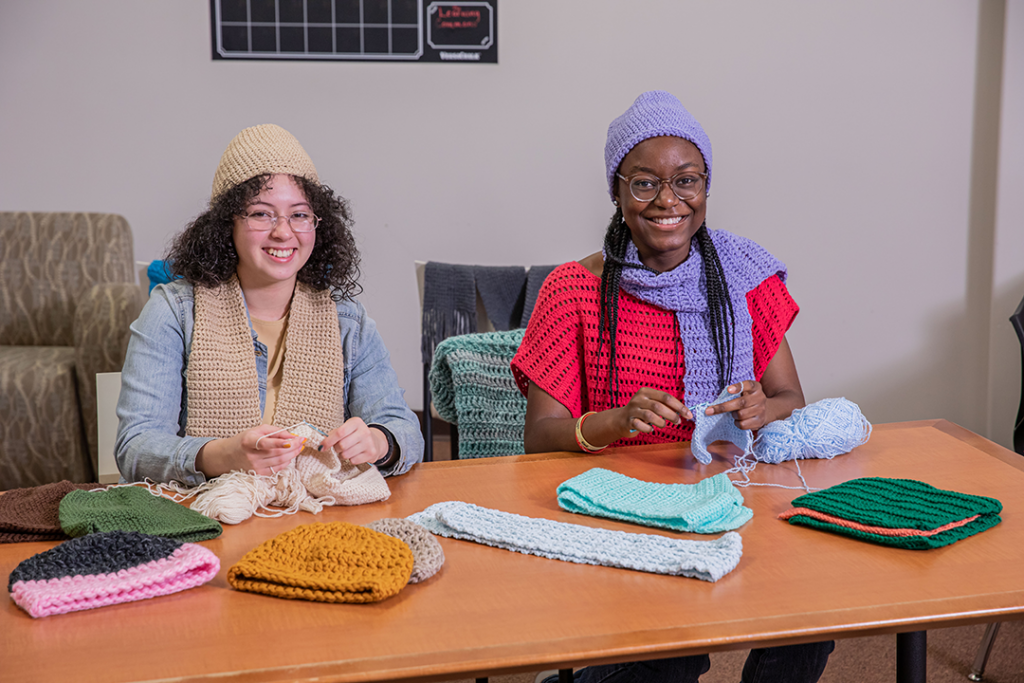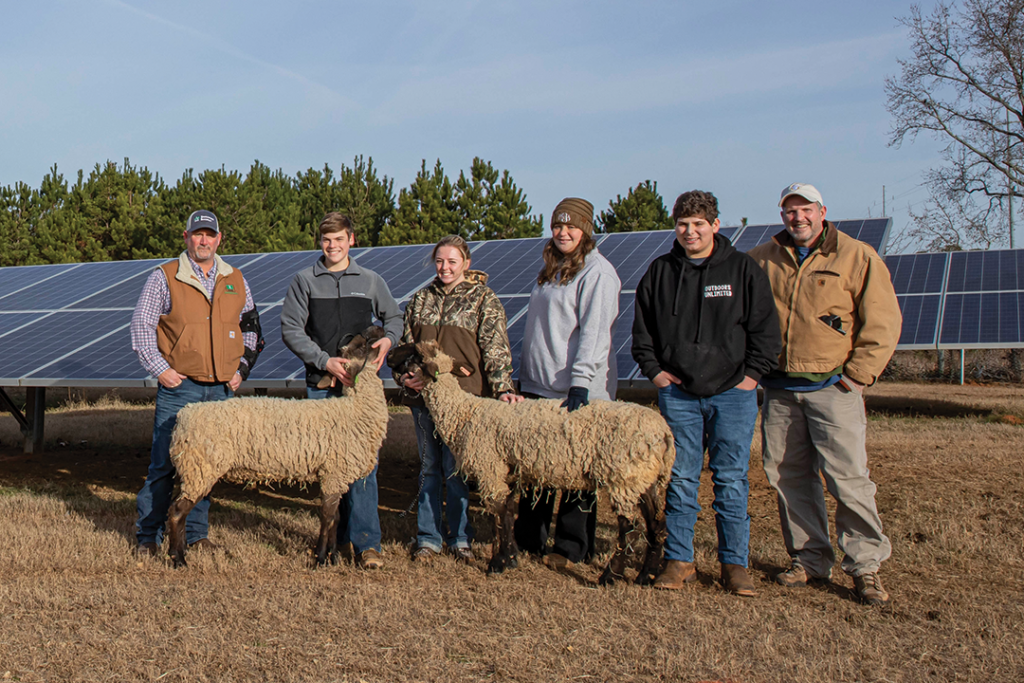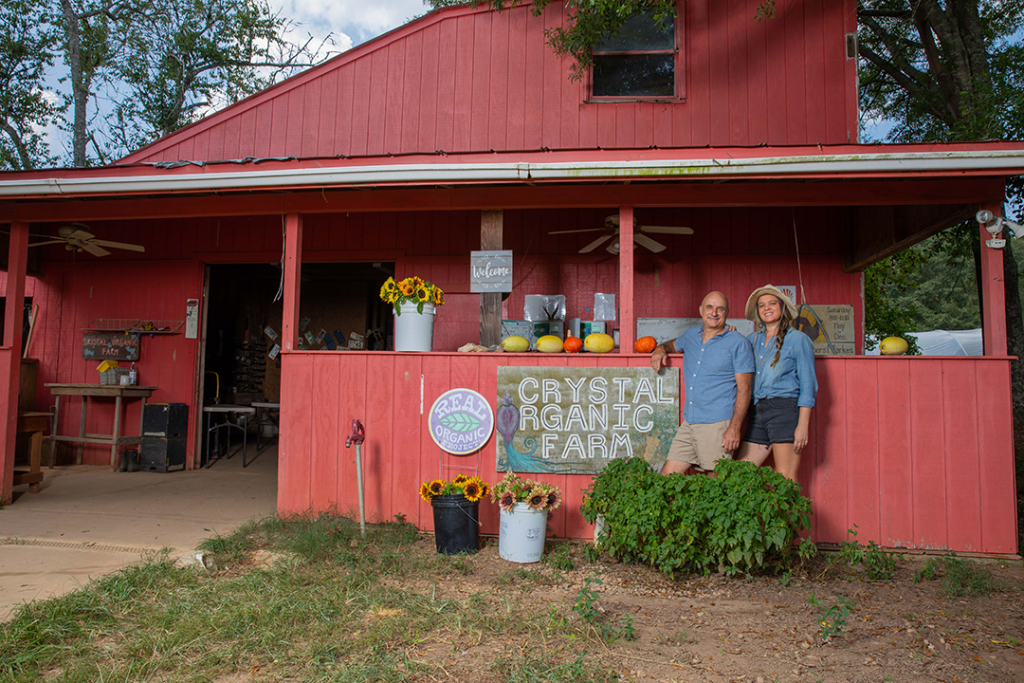As a state-certified beekeeper, Newton College and Career Academy agricultural education teacher Marcus Pollard plays a pivotal role in maintaining a healthy relationship between the public and the often-misunderstood honey bee population.
The “location, location, location” mantra applies to more than just the world of real estate. Apparently, it also has much to do with how people respond to honey bees. Observing a bee buzz from flower to flower can be a delightful experience. Discovering a “bee in your bonnet”—or in your attic? Well, not so much.
Marcus Pollard, an agricultural education teacher at the Newton College and Career Academy, has been coming to the rescue of bees and people for the past 10 years as a state-certified beekeeper. It is a small but important part of his role as advisor for the Georgia Young Farmer Program in Newton County.
“I kind of connect the community with agricultural education—the FFA chapters, the kids in the high schools and middle schools with adults,” he said. “It’s a big networking thing.”
By limiting his teaching at NCCA to only two classes, Pollard can invest more time helping landowners and citizens with all things agricultural. When the issue arises of what to do with bees, it becomes a matter of no little importance.
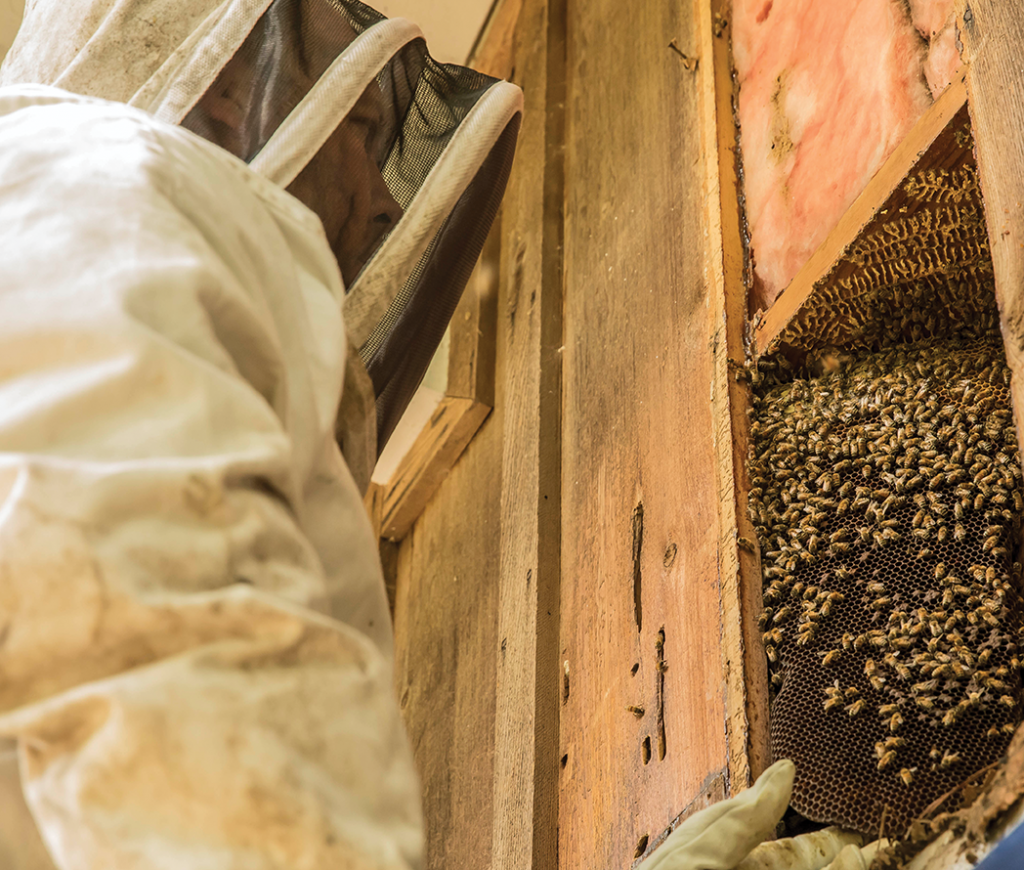
“One out of three bites of food that humans eat, a bee is 100% responsible for,” Pollard said. “The reality is that for the cow to eat the grass you have to have the bee to pollinate it.”
While pesticides in the form of neonicotinoids continue to kill large numbers of the insects, a deadly mite, aptly named the Varroa destructor, is also thinning the ranks of colonies across the country. Thankfully, there are ongoing efforts on a variety of fronts to address these and other issues facing pollinators, in general, and the honey bee, in particular.
“As a beekeeper, our job is just to optimize the conditions so that bees can produce and do their thing,” Pollard said. Those conditions can deteriorate rapidly when bees inadvertently choose to build their nests in human dwellings. “You would hope that all of them would go to a hollowed-out tree trunk or whatever, but that’s just not always the case,” he said. Homeowners fearful of stings and/or property damage often lack the knowledge and skills to deal with such an intrusion and are forced to look for outside help. “Beekeepers,” Pollard said, “typically get that phone call.”
“One out of three bites of food that humans eat, a bee is 100% responsible for. The reality is that for the cow to eat the grass you have to have the bee to pollinate it.”
Marcus Pollard
By the time Pollard took one such call from Little Springs Farm, just south of Covington, a sizeable bee hive was already firmly ensconced on the back of the house, neatly framed behind siding and between studs. The removal was neither simple nor easy. “The challenge was that it was 30 feet in the air,” Pollard said. The beekeeper needed help and found it in Newton County Young Farmer member Glenn Dowling. He contacted Sunbelt Rentals’ Joe Camadeca, who donated scaffolding to support the operation.
When moving a colony of bees, finding the queen is key, as the rest of the bees will typically follow her when she leaves the hive, according to Pollard. Because of her larger size and the movement of workers around her, she is usually easy to identify and apprehend. That was not the case at Little Springs Farm.
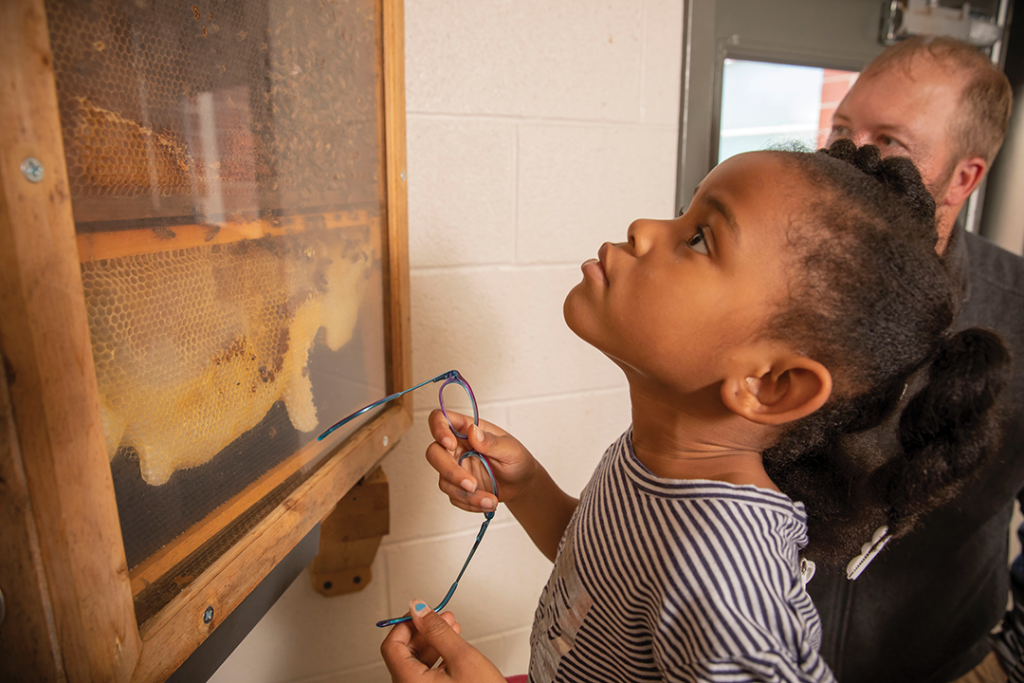
“She was running from me the entire time,” Pollard said. “As I would pull the outermost layer of honeycomb out of the hive, she would move deeper into the remaining honeycomb.” Finally, after reaching the last layer, he managed to grab her. “Well, I made an attempt,” Pollard said. “She promptly fell down the scaffolding and held on to the middle level about 15 feet below us. I was able to climb down and scoop her up.”
Queen and colony were soon transferred to Mansfield Elementary School, where an observation hive sat empty, its former residents having been victims of a mite infestation. Students, particularly second-graders, have utilized hives at the school to study bees and their life cycles for the past seven years, according to Sarah Nichols, a school office secretary who also works with the afterschool program’s Farm to School Initiative.
“The kids love to watch the queen and the whole hive just work,” she said. One of the first realities students learn is that swatting at a bee is generally not a good idea, because it will be interpreted as a sign of aggression. Honey bees sting but normally only in self-defense. “We discuss that the bees don’t want to sting them because they don’t live after that,” Nichols said. Students are also able to learn about the importance of bees as pollinators as they see the process firsthand in the pollination garden located just outside the observation hive.
Pollard credits the successful relocation of the bees, from house to school, to a community effort that began with the homeowner. “It all wouldn’t have been possible without Little Springs Farm deciding to try to keep the bees as opposed to calling an exterminator,” he said.
Another kind of call that Pollard commonly receives tends to come from a landowner who has spotted a large mass of bees, often hanging from a tree branch. Though encountering a basketball-sized swarm containing thousands of bees can be a frightening experience, it need not be, according to Pollard. Because they have left their hive, they have no honey or honeycomb. “There is nothing to defend,” he said, “so this is actually when they are the most docile.” Swarming is simply the natural process through which bee colonies multiply by dividing. “They reproduce by one hive becoming two,” Pollard said.
Though the queen is responsible for populating the colony by laying as many as 2,000 eggs per day, the worker bees are the real movers and shakers when it comes to getting vital tasks done. They not only feed and attend to the queen constantly, but they also build the honeycomb and clean its cells, handle incoming nectar, feed the brood, guard the entrance to the hive and cool and ventilate it when necessary. In addition, they guide community activities by continuously evaluating conditions in and around the hive.
When it is determined that the hive is becoming crowded or nearby resources are too limited to support the colony, worker bees will choose 6–12 eggs out of the thousands stored in the hive and feed them a kind of super-food called “royal jelly,” creating a queen. When the current queen senses she is about to be replaced, she leaves the hive, or swarms.
“She’s big. She doesn’t like to fly, and so, she’s going to hang on to something very close to the hive,” Pollard said. “About half of the current hive will go and hang with her.” While the rest wait, a number of scout bees will scatter, searching for an open but protected place to make a new home. “One scout finds something. It comes back. Another scout finds something. It comes back,” Pollard said. “Then [all the scouts] do a little dance, and whoever has the most exciting dance wins.” Having reached a consensus, the hive lifts as one and flies to its new home where the whole process begins again.
Meanwhile, back at the old hive, a power struggle ensues among the half a dozen or so queens that have hatched.
“They will fight to the death, and then the last one standing is the new queen,” Pollard said. “So it is with nature: One hive becomes two.”
Whenever possible, Pollard relocates bee colonies to NCCA, where they will fill either the observation hive situated inside a classroom or one of several hives located outside the school. Under Pollard’s tutelage, students outfitted in full beekeeper gear learn the art and science of beekeeping and how to make lip balm and candles with the wax.
Out in the community, Pollard can often relocate hives to beekeepers needing new or replacement bees. He wishes more people understood the “power of pollination” and took on beekeeping.
“Bees are struggling; bees are dying,” he said. “Anybody that could lend a hand really has a compound effect on their communities.”
Fun Facts
• It takes 12 bee lifetimes to make a teaspoon of honey.
• From hive to flower and back, it takes 2,000,000 trips and 50,000 miles of flight to produce a pound of honey.
• Honey is (technically) not bee vomit since it does not come from the stomach. It is regurgitated from another organ.
For more information or help concerning honey bees, contact Marcus Pollard via email at pollard.marcus@newton.k12.ga.us.
Click here to read more stories by David Roten.

